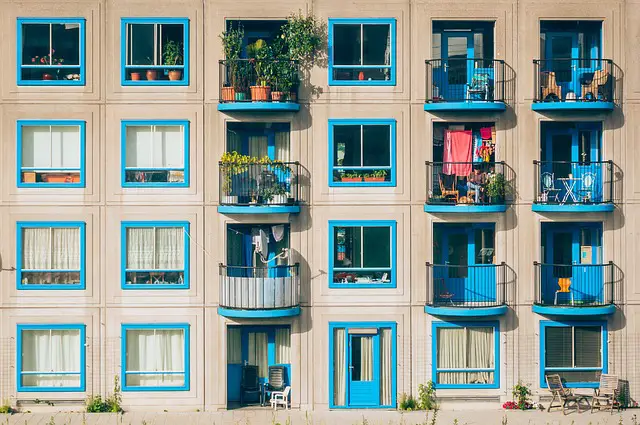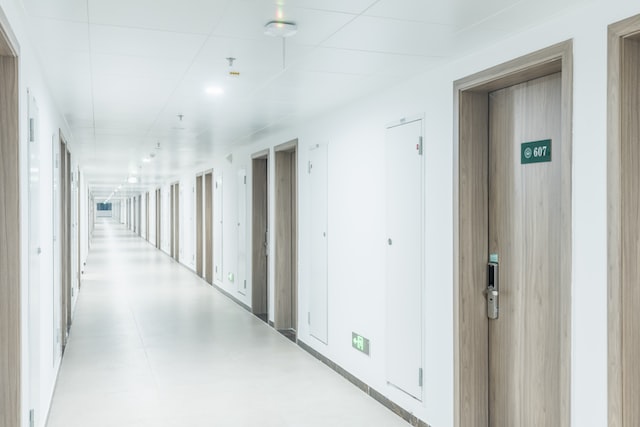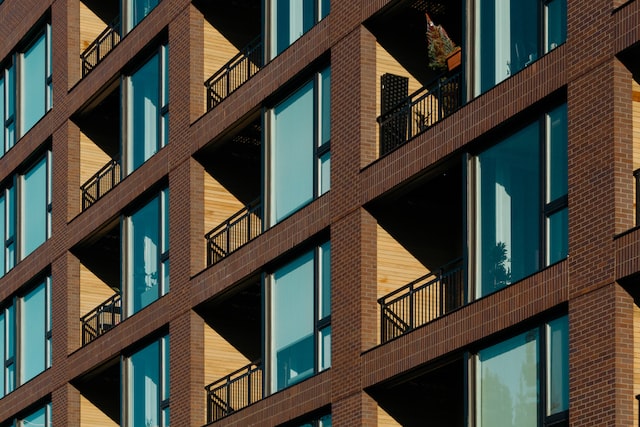Apartments are private residences while dormitories are shared living spaces. Apartments come in all shapes and sizes, but they typically have a kitchen, living room, and bedroom (or multiple bedrooms) while dormitories have a common area and bedroom (or multiple bedrooms). Dormitories also typically have communal bathrooms. Another key difference is that apartments are usually more expensive than dormitories.
What is an apartment?
(Image by Pexels from Pixabay )

An apartment is a self-contained unit that forms part of a larger building. An apartment typically has its own entrance, kitchen, bathroom and bedroom(s). Apartments are usually located on one level of a multi-story building, but may also be found in duplexes, triplexes and quadplexes.
What is a dormitory?
(Photo by Scarbor Siu on Unsplash )

A dormitory is a type of student housing in which students share bedrooms and common living areas. Dormitories are typically found on college campuses, but may also be available through some high schools and other educational institutions. Students who live in dormitories are typically required to follow certain rules and regulations, such as quiet hours and curfews.
The difference between an apartment and dormitory
There are several key differences between apartments and dormitories that renters should be aware of before signing a lease. For starters, apartments are typically more expensive than dorms, as they offer more privacy and amenities. Secondly, apartments generally require a longer lease term than dorms – typically one year compared to nine months for most dorms. Finally, apartments are typically unfurnished whereas dorms come with furniture provided.
Cost
One of the most significant differences between apartments and dormitories is the cost. Typically, apartments are more expensive than dormitories. Rent for an apartment can range from a few hundred to several thousand dollars per month, while the cost of a dormitory room is typically lower. This difference in cost is due to the size, amenities, and location of the two types of housing. Apartments tend to be larger and offer more amenities than dormitories, which are often located in areas with lower rent prices.
Space
Another important difference between apartments and dormitories is the amount of space available. Apartments typically offer more space than dormitories. An apartment usually has a living room, kitchen, bedroom, and bathroom, while a dormitory room usually only has a bed, a desk, and a small closet. Apartments also offer more privacy than dormitories, as residents have their own private space to live in.
Privacy
Privacy is another key difference between apartments and dormitories. In an apartment, residents have their own private living space and are usually not required to share common areas with other residents. In a dormitory, residents typically share common areas such as bathrooms, kitchens, and lounges. This can be an issue for some people who value their privacy and want to have their own space.
Lifestyle
The lifestyle of the residents is also different in apartments and dormitories. Apartments tend to attract more mature and independent residents who are looking for a place to live on their own. Dormitories, on the other hand, tend to attract younger residents who are just starting out in their careers or pursuing their education. The lifestyle in a dormitory is often more social and communal, as residents interact with each other in shared spaces.
Which is better dorm or apartment?
If you’re wondering whether you should live in a dorm or an apartment, there are a few things to consider. Dorms are typically smaller and more affordable than apartments, but they also come with some downsides. For one, you’ll have to share a bathroom with your dorm mates, and there’s usually less privacy overall. Additionally, dorms are usually located on or near college campuses, so if you’re not a big fan of the college scene, living in a dorm may not be ideal. Apartments, on the other hand, offer more space and privacy, but they can be more expensive and may require a longer commute to campus. Ultimately, the decision of whether to live in a dorm or an apartment comes down to your personal preferences and budget.
Can married couples live in dorms?
Living in a dormitory is a unique experience that offers many benefits, but it is not for everyone. For married couples, living in a dormitory can be challenging. Here are some things to consider before making the decision to live in a dorm:
- Cost: Dormitories are typically cheaper than apartments, so if cost is a factor, this may be an appealing option.
- Location: Dormitories are usually located near college campuses, so if convenience is important, this may be a good choice.
- Privacy: Dormitories can be noisy and chaotic places, so privacy may be difficult to come by. If you value your privacy, an apartment may be a better option.
- Amenities: Many dormitories offer amenities such as laundry facilities and common areas. If these amenities are important to you, living in a dorm may be a good choice.
Is an apartment cheaper than a dorm?
There are many factors to consider when determining whether an apartment is cheaper than a dorm. The cost of living in an apartment varies depending on the location, size, and amenities of the unit. Dorms, on the other hand, are typically priced per semester and include utilities and other services. When comparing the two, it is important to consider the total cost of living in each type of housing.
Generally speaking, apartments are more expensive than dorms. However, there are some circumstances under which an apartment may be cheaper than a dorm. For example, if you have roommates in an apartment, you can split the cost of rent and utilities between all tenants. This can make apartments more affordable than living in a dorm alone. Additionally, some apartments offer discounts for students or those who sign a long-term lease. These discounts can make renting an apartment more affordable than living in a dorm room.
What are the common features of a dormitory?
Most dormitories have common features that make them distinct from apartments. Dormitories are usually found on college campuses, and they typically house multiple students in one large building. each student usually has their own small room, but they share common areas like bathrooms and kitchens with the other residents.
Dormitories also have rules and regulations that residents must follow, such as quiet hours and curfews. And because dorms are designed for students, many of them come with amenities like study lounges, laundry facilities, and recreation rooms.
What are the common features of an apartment?
Common features of an apartment include:
- Living space
- Bedrooms
- Kitchen
- Bathroom(s)
- Balcony/Patio (in some units)
- Closet/Storage space
- Laundry facilities (sometimes in-unit, sometimes shared)
- Flooring (often carpet or vinyl)
- Lighting fixtures
- Electrical outlets and switches
- Windows and window coverings.
Can you room with the opposite gender in college?
The simple answer is yes, you can room with the opposite gender in college. In fact, most colleges have co-ed dorms where students of both genders live on the same floor or in the same building. However, there may be some restrictions on who you can room with, such as only being able to room with another student who is also in your major or who is a similar age. Additionally, some colleges may have gender-neutral housing options available for students who prefer not to room with someone of the opposite gender.
What is the main purpose of a dormitory?
The main purpose of a dormitory is to provide a place for students to live while they are attending school. Dormitories are usually much cheaper than apartments, and they offer students the opportunity to live in close proximity to their classmates and other students.
What are some common rules for living in a dormitory?
If you are planning to live in a dormitory, there are a few things to keep in mind. For starters, most dormitories have strict rules about visitors and quiet hours. You will also need to be respectful of your roommates and their belongings. Additionally, most dorms have communal kitchens and bathrooms, so it is important to be tidy and clean up after yourself. Finally, be sure to follow the rules set by your dormitory staff, as they are there to ensure that everyone has a safe and enjoyable experience.
What are some common rules for living in an apartment?
There are a few common rules that apply to living in an apartment. One is that you are responsible for your own space and for keeping it clean. You will also be responsible for any damage you cause to the apartment, so it’s important to be careful. Another rule is that you need to respect your neighbors and their space. This means keeping noise levels down, not being disruptive, and being considerate of their schedules and needs. Lastly, you will need to follow the building’s rules and regulations. These can include things like quiet hours, visitors, parking, and trash disposal.
What are the types of dormitories?
There are generally two types of dormitories: On-campus and Off-campus. On-campus dormitories are owned and operated by the school, while off-campus dormitories are privately owned.
On-campus dormitories are typically smaller than off-campus dormitories, with fewer amenities. Off-campus dormitories may have their own kitchens and living rooms, while on-campus dormitories usually have a shared kitchen and living room.
Off-campus dormitories may be more expensive than on-campus dormitories, but they offer more privacy and independence.
The other type of dorms are:
- Traditional dormitories: usually have shared bedrooms, bathrooms, and common spaces
- Suite–style dorms: have semi-private or private bedrooms with a shared bathroom and common spaces
- Apartment–style dorms: have private bedrooms and bathrooms, and a shared kitchen and living room
- Co–ed dorms: allow both male and female residents to live together
- Single–gender dorms: separate facilities for male and female residents
- International dorms: designed for international students and often have a more diverse community
- Honors dorms: for high-achieving students with special programs and services
- Substance–free dorms: a drug and alcohol-free living environment
- Disability–accessible dorms: designed for students with disabilities.
What are the types of apartments?
- Studio Apartment – Typically one large room that serves as a living room, bedroom, and kitchen, with a separate bathroom.
- One Bedroom Apartment – Consists of one bedroom, a living room, a kitchen, and a bathroom.
- Two Bedroom Apartment – Consists of two bedrooms, a living room, a kitchen, and a bathroom.
- Three Bedroom Apartment – Consists of three bedrooms, a living room, a kitchen, and a bathroom.
- Loft Apartment – Typically a large open space with high ceilings, exposed ductwork, and industrial-style features, often converted from commercial or industrial buildings.
- Duplex Apartment – A two-story apartment that has living space on two levels, typically with separate entrances for each floor.
- Triplex Apartment – A three-story apartment that has living space on three levels, typically with separate entrances for each floor.
- Serviced Apartment – A fully furnished apartment that includes housekeeping and other services, often aimed at short-term renters or travelers.
- Micro Apartment – A small apartment, usually less than 300 square feet, designed to maximize space through efficient use of furniture and layout.
- Penthouse Apartment – A luxury apartment on the top floor of a building, often featuring high-end finishes, large balconies or terraces, and sweeping views.
What are the advantages and disadvantages of living in a dormitory?
Advantages of living in a dormitory:
- Convenience – Dormitories are often located on or near college or university campuses, making it easy for students to attend classes and participate in campus life.
- Cost-effective – Dorm living can be more affordable than living off-campus, especially in expensive cities.
- Social Opportunities – Living in a dorm provides a chance to meet and interact with people from different backgrounds and cultures, which can be a great opportunity for personal and intellectual growth.
- Access to Resources – Dormitories often have communal spaces, such as lounges, kitchens, and laundry facilities, that students can use.
- Support Services – Some dorms offer support services, such as counseling and tutoring, that can help students adjust to college life and succeed academically.
Disadvantages of living in a dormitory:
- Lack of Privacy – Dorms are often designed to maximize space, meaning that residents may have limited privacy or personal space.
- Noise – Living in close quarters with other students can lead to noise issues, especially if residents have different schedules or lifestyles.
- Limited Amenities – While dormitories may have communal spaces, they may not have the same range of amenities as off-campus housing.
- Roommate Issues – Living with a roommate can be a challenge, especially if residents have different lifestyles or schedules.
- Restrictions – Dormitories often have strict rules and regulations, such as curfews and restrictions on guests, that can be restrictive for students.
What are the advantages and disadvantages of living in an apartment?
Advantages of living in an apartment:
- Affordability – Renting an apartment is often more affordable than owning a house, especially in expensive cities.
- Location – Apartments are often located in more densely populated areas, providing easy access to public transportation, shops, restaurants, and other amenities.
- Maintenance and Repairs – Maintenance and repairs are typically the responsibility of the landlord, which can be convenient for renters.
- Amenities – Some apartment buildings offer amenities such as a gym, pool, or laundry facilities that may not be available or affordable for individual homeowners.
- Flexibility – Renting an apartment provides more flexibility than owning a house, allowing renters to move more easily when their needs change.
Disadvantages of living in an apartment:
- Lack of Space – Apartments are often smaller than houses and may not have enough space to store belongings or accommodate a growing family.
- Noise – Living in close proximity to other residents can lead to noise issues, such as loud neighbors or street noise.
- Landlord Restrictions – Renters may be subject to restrictions imposed by the landlord, such as limitations on modifications to the apartment or restrictions on pets.
- Lack of Privacy – Living in an apartment building can reduce privacy compared to living in a single-family home.
- Security Concerns – While some apartment buildings may have security measures in place, renters may still be concerned about safety and theft.
Featured Image By – Photo by Matt Reames on Unsplash








